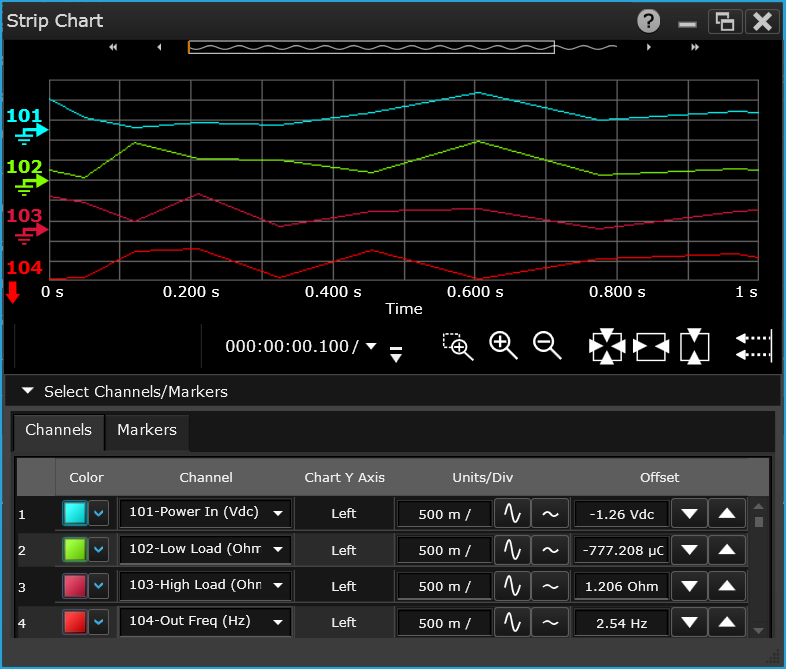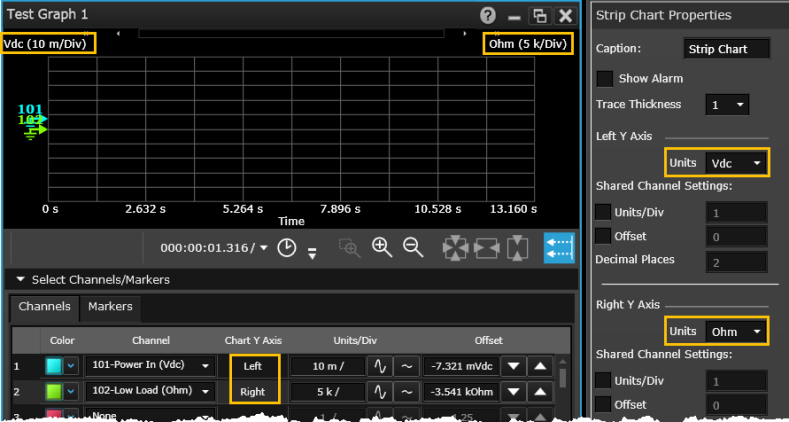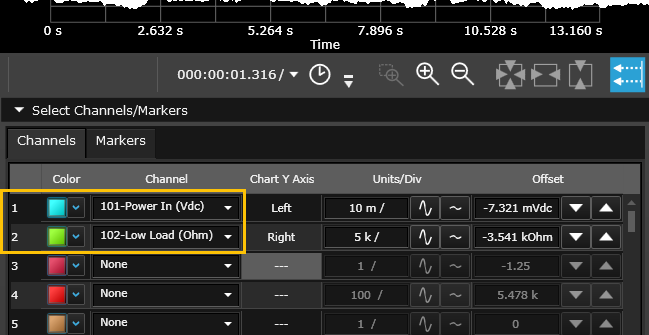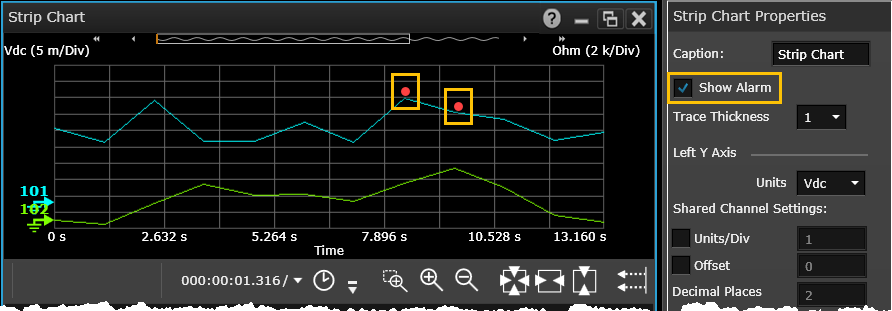

Display scan data as a strip chart with up to 40 channels per strip chart. You can add up to 10 strip chart gadgets on the Graphics Setup tab.
Note: To enable faster chart refresh times while a scan is in progress, some zoom and auto-scale toolbar controls are disabled if more than four (4) channels are added to the Strip Chart. To re-enable these toolbar controls, either stop the scan or limit the number of displayed channels to four (4) or fewer.

Note: This gadget is available in the Scan Module configuration only. If you have selected the Switch Module configuration on the Instrument Settings tab, this gadget will not be allowed for this module.


Select the desired gadget window (the selected window is highlighted in blue) to display the Properties pane on the right side of the Graphics Setup tab. The available properties vary according to the type of gadget selected.
Caption - Enter the desired title to appear at the top of the current gadget window. You can specify a caption with up to 30 characters including letters, numbers, and special characters.
Show Alarm - Select the checkbox to shown alarm limit conditions as red circles on the strip chart trace.

Trace Thickness - Set the thickness of the displayed trace to a value between 1 (default, thin trace) and 5 (thick trace).
Left/Right Y Axis Units - Set the unit labels for the graph's Y Axis. You can define a different label for the left and right side of the graph, but they cannot be the same units. Select "All" from the drop-down list to display the selected channels on the graph with no axis labels.
Left/Right Shared Channel Settings - Click a checkbox to share the same units per division and/or offset reference level on the left and right side of the graph. For each axis, you can also specify the graticule label precision in number of digits to the right of the decimal (0 through 9).
Column Separator - This is a global setting for all gadgets that display data from a scan. Select the desired separator from the drop-down list – tab, comma, or semicolon. Click the Copy Data to Clipboard button to export the data from the current gadget to the Windows clipboard.
Copy Image to Clipboard - Export a screen shot of the selected display gadget to the Windows clipboard.
1. Auto Populate - Automatically load the strip chart with channels in the specified channel range (channels must be in the current scan list).
2. Delete Channels – Delete channels in the specified channel range from the data grid.
The Data Preview Bar gives a visual indication of the portion of the data that is currently displayed in the chart. The area highlighted in grey is the portion of the data that is currently displayed.


|
Set the x-axis grid labels. Select from "Relative to Zero" (default), "Date Time" in local time, or "Date Time (UTC)" relative to Universal Time Coordinated time. |

|
Insert text annotation on the graph. To insert a text annotation, click |

|
Show vertical markers. Click |

|
Area zoom. Use the mouse to draw a frame around the desired area of the graph to zoom in on. |

|
Zoom in horizontally. To zoom in vertically only, click on the waveform (waveform turns into a thick line) and zoom in. Click the waveform again to return to the normal zoom mode. |

|
Zoom out horizontally. To zoom out vertically only, click on the waveform (waveform turns into a thick line) and zoom out. Click the waveform again to return to the normal zoom mode. |

|
Auto scale the trace on both the x- and y-axis. |

|
Auto scale the trace on the x-axis. |

|
Auto scale the trace on the y-axis. |

|
Automatically scroll new trace data from the right side of chart. Click the drop-down arrow next to this icon to auto scale the x-axis, y-axis, or both when appending new trace data. |
When a graph is displayed, you can position two vertical markers to display measurement data for each marker position and display the relative measurement data between the markers (∆M2 ‑ M1). To link specific channels in the current scan list to the two markers, go to the Select Channels/Markers drop-down at the bottom of the gadget window, click on the Markers tab, and then select the desired channel for each.

If the markers are not being displayed on the graph, click  to display markers.
to display markers.
To position the markers, click  or
or  and drag the marker left or right. The example above shows marker 1 and marker 2 positioned on the graph with the corresponding marker measurement data displayed below the graph. In this example, Channel 101 is linked to marker 1 and Channel 102 is linked to marker 2.
and drag the marker left or right. The example above shows marker 1 and marker 2 positioned on the graph with the corresponding marker measurement data displayed below the graph. In this example, Channel 101 is linked to marker 1 and Channel 102 is linked to marker 2.
When a marker is moved off the graph (by zooming in on the trace, for example), it appears at the upper left or right corner of the graph.
To hide markers, click  .
.
Select Lock to grid to lock markers position on the chart and monitor the auto scrolling data that passes through the Vertical Markers.
Right-click anywhere on the Strip Chart to display these options:
Save Chart Image to File - Export a screen shot of the chart to a JPEG, BMP, or PNG file, with a white grid on a black background. By default, the screen shot is stored in the "My Documents" folder on your computer. For example – C:\Users\<user_name>\Documents\Keysight\BenchVue\DAQ\Exports\.
Copy Chart Image to Clipboard - Export a screen shot of the chart to the Windows clipboard.
Copy Data to Clipboard - Export the data from the current gadget to the Windows clipboard.
Undo Auto Scale - Undo auto scale and return the chart to its previous display settings.